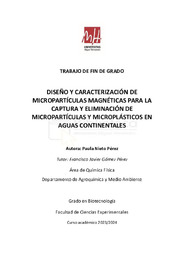Resumen :
El presente Trabajo de Fin de Grado evalúa la capacidad de micropartículas de magnetita, Fe3O4, recubiertas de sílice, SiO2, y del polielectrolito catiónico cloruro de polidialildimetilamonio, PDADMACl, (Fe3O4@SiO2@PDADMACl) para capturar nanopartículas de poliestireno (látex) y de sílice tomadas como modelos de partículas hidrofóbicas e hidrofílicas, respectivamente. En primer lugar, se caracterizó la capacidad de adsorción de estas partículas de magnetita para adsorber ligandos solubles (en particular, el colorante azul de tripano y la albúmina del suero bovino, BSA). Las partículas de magnetita mostraron una moderada capacidad de unión de estos ligandos de carga opuesta (aniónicos) obteniéndose valores para la capacidad máxima de adsorción, qmáx, de 25.6 y 84.7 mg de ligando por g de partícula para el azul de tripano y la BSA, respectivamente. Estos valores fueron discutidos en términos del tamaño molecular del ligando en comparación con su superficie de adsorción a la partícula de magnetita. Las partículas de magnetita demostraron tener una enorme capacidad para capturar y eliminar del medio acuoso tanto las partículas de látex como de sílice. La qmáx para estas nanopartículas es órdenes de magnitud superior a la determinada para los ligandos solubles: 1 g de partículas de Fe3O4@SiO2@PDADMACl es capaz de adsorber 2.65 g y 9.54 g de nanopartículas de látex y sílice, respectivamente. Esto resultados demuestran que la metodología propuesta puede ser optimizada para su utilización en la captura y eliminación de estos contaminantes de diversos ecosistemas.
This Final Degree Project evaluates the ability of magnetite microparticles, Fe3O4, coated with silica, SiO2, and the cationic polyelectrolyte poly diallyl dimethyl ammonium chloride, PDADMACl, (Fe3O4@SiO2@PDADMACl) to capture polystyrene (latex) and silica nanoparticles taken as models of hydrophobic and hydrophilic particles, respectively. First, the adsorption capacity of these magnetite particles to adsorb soluble ligands (in particular, trypan blue dye and bovine serum albumin, BSA) was characterized. The magnetite particles showed a moderate binding capacity of these oppositely charged (anionic) ligands obtaining values for the maximum adsorption capacity, qmax, of 25.6 and 84.7 mg ligand per g of particle for trypan blue and BSA, respectively. These values were discussed in terms of the molecular size of the ligand compared to its adsorption surface to the magnetite particle. Magnetite particles proved to have an enormous capacity to capture and remove both latex and silica particles from the aqueous medium. The qmax for these nanoparticles is orders of magnitude higher than that determined for soluble ligands: 1 g of Fe3O4@SiO2@PDADMACl particles is capable of adsorbing 2.65 g and 9.54 g of latex and silica nanoparticles, respectively. These results show that the proposed methodology can be optimized for use in the capture and elimination of these pollutants from various ecosystems.
|
 La licencia se describe como: Atribución-NonComercial-NoDerivada 4.0 Internacional.
La licencia se describe como: Atribución-NonComercial-NoDerivada 4.0 Internacional.
.png)
